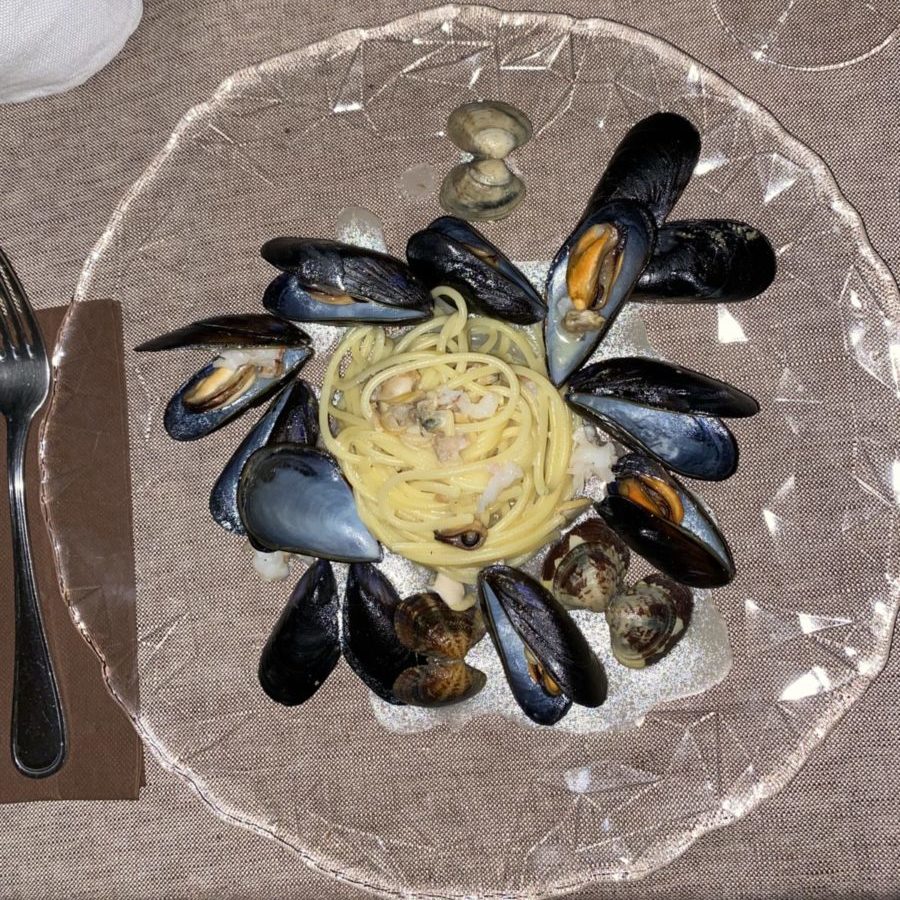The culinary tradition of Versilia is characterized by fish, meat, and excellent local products. It reflects the variety of its territory, ranging from the sea to the hills and mountains.
COASTAL DISHES
Typical dishes of the coast have fish as their main ingredient, often originating from the habits of local fishermen. Some examples include “sparnocchi con i fagioli schiaccioni di Pietrasanta” (a dish of sparnocchi fish with mashed beans from Pietrasanta), “spaghetti alla Trabaccolara,” “spaghetti con le arselle” (spaghetti with razor clams), or with “coltellacci,” “caciucco” (a fish stew), and “risotto con seppie e bietola” (risotto with cuttlefish and chard).
- “Sparnocchi” is the dialect term for mantis shrimp, while “fagioli schiaccioni” are a Slow Food Presidium and also a Traditional Agri-Food Product of the Tuscany Region. It is a variety of white bean with a more delicate flavor compared to red beans. It is excellent boiled and dressed with a drizzle of olive oil or as a side dish for flavorful meats. “Sparnocchi con i fagioli” is a simple recipe that allows you to enjoy the raw ingredients. The shelled beans are cooked in water with sage, garlic, and extra virgin olive oil. The whole mantis shrimps (without the intestinal thread) are boiled separately in boiling water. Then they are combined with the well-drained beans, a bit of raw oil, and some pepper.
- Historically, ‘spaghetti alla trabaccolara‘ originated as a poor dish made by fishermen with the unsold catch of the day at the fish market, such as gurnards, scorpionfish, and weever fish, for example. The trabaccolo was a small fishing boat used for fishing, originally from the Marche region and imported to Viareggio in the early decades of the 20th century. In a pan with extra virgin olive oil, a minced mixture of garlic, chili pepper, onion, and parsley is sautéed. Diced fresh tomatoes, peeled and deseeded, are added. When the tomato water has evaporated, the fish is added and flamed with wine.
- Spaghetti with arselle (‘nicchi’ in the local dialect or telline): arselle are bivalve mollusks caught on the seabed with special rakes. They are sautéed in a pan with garlic and deglazed with wine; it is possible to add fresh raw tomato. Arselle are also used to make a seafood sauce that accompanies ‘matuffi,’ a dish made of polenta, usually served with mushroom sauce or meat sauce.
- Spaghetti with coltellacci: ‘coltellaccio’ is the dialect term for razor clams, mollusks with a narrow and elongated shape. The sauce can be made either plain or with tomato, as in the case of the sauce with arselle. In Viareggio, there is also a song called ‘Cha cha cha dei Coltellacci’ that you can definitely hear if you happen to visit the evening neighborhood parties during Carnival in February.
- Caciucco is a fish soup made with small pieces of fish. Unlike the Livornese version, it is mainly cooked with fish from sandy bottoms rather than rocky ones and has a delicate flavor instead of being spicy. It is cooked using gurnards, cuttlefish, mantis shrimp, scorpionfish, red mullets, and silver scabbard fish; sometimes, conger eel and octopus are added, although there is no precise rule on which fish to use because the fishermen who ‘invented’ it used the fish they had available each time.”
In Versilia, it’s also possible to taste dishes based on bluefish (anchovies, sardines, and mackerel), as well as clams, turbot, squid, mantis shrimp, sole, and red mullet.
DISHES FROM THE INLAND
Moving inland, we primarily find dishes based on meat and vegetables such as: tordelli (with a “d”, not tortelli!), Scarpaccia, Putta Pasquale cake from Pietrasanta (made with rice, spelt, and various spices), but also soups like zuppa alla frantoiana and kale soup, matuffi (polenta with sausage or mushroom sauce), pasta e ceci (pasta with chickpeas) or pasta e fagioli (pasta with beans), rabbit with olives, and grilled meat.
- Tordelli are often found on the menus of restaurants and taverns in the area: typical Versilia tordelli are filled with meat, chard, and wild thyme, and served with meat ragù. The pasta is thick and usually without eggs
- Scarpaccia is a savory cake made with zucchini from the Camaiore area; instead, in Viareggio, it is made with sugar and is a dessert.
- Zuppa alla frantoiana is a soup made with vegetables, legumes, and freshly pressed extra virgin olive oil. It was offered to farmers and laborers during the olive harvest and also served to test the quality of the newly produced oil.
As for desserts, on the coast, we find rice cake, ciacci or necci, befanini made for Epiphany, cenci (small squares of sweet pastry, fried and coated with powdered sugar), and rice fritters, both for Carnival.
- Ciacci or necci are made with a semi-liquid dough based on chestnut flour and cooked on iron discs. They resemble flatbreads and are now served with ricotta and sugar as a dessert, while originally they were a single dish also served with cold cuts.
Inland, instead, we have castagnaccio, a soft and moist cake made with chestnut flour, oil, water, and without yeast.
The Versilia area also boasts excellent typical products: olive oil, honey, wine, bread, and cured meats from Gombitelli.
Gombitelli is a village at 500 meters above sea level in the municipality of Camaiore known for its pork butchery tradition: its coarse-grained salami and lard deserve to be mentioned and tasted.
To promote olive oil and wine, there are two fairs: Enolia at the Medici Palace in Seravezza in April, and Prim’olio e Primo Vino in Camaiore in December.

